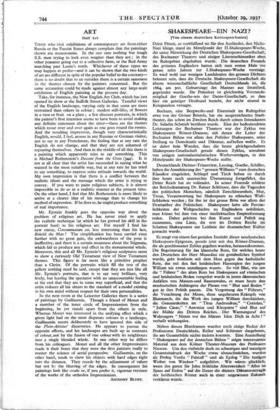ART
Dult Art
THOSE who visit exhibitions of contemporary art from either Russia or the Fascist States always complain that the paintings shown are monotonous. In the one case nothing but tough S.S. men trying to look even tougher than they are ; in the other peasants going out to a collective farm, or the Red Army marching past Lenin's tomb. Whichever of these types we may happen to prefer—and it can be shown that the two kinds of art are different in spite of the popular belief to the contrary— there is no doubt that to an outsider there is a certain sameness in the themes chosen by the painters concerned. But the same accusation could be made against almost any large-scale exhibition of English painting at the present day.
Take, for instance, the New English Art Club, which has just opened its show at the Suffolk Street Galleries. Tasteful views of the English landscape, varying only in that some are more restrained than others in colour ; modest still-fifes, of flowers in a vase or fruit on a plate ; a few discreet portraits, in which the painter's first intention seems to have been to avoid making any definite statement about the sitter—these are the themes which recur over and over again as one goes round the rooms. And the resulting impression, though very characteristically English, would, I feel, arouse in any Russian or German visitor, not to say in any Frenchman, the feeling that at any rate the English do not change, and that they are not ashamed of repeating themselves. And then in the middle of all this there is a painting which apparently tries to say something. This is Michael Rothenstein's Descent from the Cross (344). It is not at all clear that the artist has succeeded in saying what he wanted in the most suitable way, but at any rate he has tried to say something, to express some attitude towards the world. My own impression is that there is a conflict between the realistic idiom and the message which the artist is trying to convey. If you want to paint religious subjects, it is almost impossible to do so in a realistic manner at the present time. On the other hand, I feel that Mr. Rothenstein is more likely to arrive at a dearer idea of his message than to change his method of expression. If he does so, he might produce something of real importance.
Mr. Epstein frankly goes the opposite way about the problem of religious art. He has never tried to apply the realistic technique (at which he has proved his skill in the portrait bust) to his religious art. For myself I find his new statue, Consummatum est, less interesting than his last, Behold the Man ! The simplification has been carried even further with no great gain, the awkwardness of the pose is ineffective, and there is a certain meanness about the Stigmata, which fail to produce any real effect in the monumental whole. Moreover, this and all Mr. Epstein's religious sculptures seem to show a curiously Old Testament view of New Testament themes. This figure is far more like a primitive prophet than a Christ. Of the portraits which fill the rest of the gallery nothing need be said, except that they are just like all Mr. Epstein's portraits, that is to say very brilliant, very lively, but leaving the spectator with an unaccountable feeling at the end that they are in some way superficial, and that the artist reduces all his sitters to the standard of a model existing in his own mind without respect for their own personalities.
In the next room at the Leicester Galleries there is a series of paintings by Guillaumin. Though a friend of Monet and a member of the inner circle of Impressionism from the beginning, he yet stands apart from the others in style. Whereas Monet was interested in the unifying effect which a given light had on the most disparate colours in a landscape, Guillaumin seems deliberately to have ignored this side of the Plein-Atristes' discoveries. He appears to pursue the opposite effects, and his landscapes are built up in contrasts of colour, not by the fusion of one colour with its neighbours into a single blended whole. Ih one other way he differs from his colleagues. Monet and all the other Impressionists made it their boast that they were the first painters really to master the science of aerial perspective. Guillaumin, on the other hand, tends to show his objects with hard edges right into the distance. They recede by the adjustment of values but not by the blurring of the edges. In consequence his paintings look hie crude or, if you prefer it, vigorous versions of the works of the orthodox Impressionists.
ANTHONY BLUNT.


























































 Previous page
Previous page